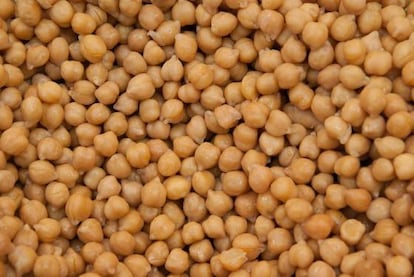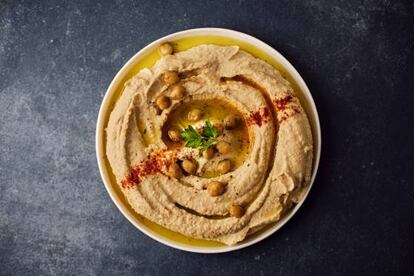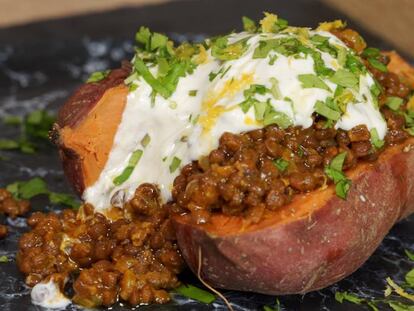How to cook chickpeas: Everything you need to know to prepare this versatile legume
If you don’t like them, it may be because you haven’t tried the right recipe or learned how to cook them properly

One mission that we will never abandon is to encourage the consumption of legumes. So after our guide to preparing lentils, the easiest legume, comes this guide on cooking chickpeas, the most versatile legume. Chickpeas can be eaten cooked and in spreads, as hamburgers or flours, from salads to soups.
You can cook them long and slow until they are creamy, perfect for a spoon dish, or leave them al dente for a salad. They taste good on their own and with a variety of spices, sauces, vegetables or animal products. Have I mentioned that I like chickpeas? I hope you do too. And if you don’t, it may be because you haven’t tried the correct recipe or you need to learn how to cook them.
Whatever type of chickpeas you choose, the preparation method is the same. You must first soak them and then cook them. There are different ideas about the art of soaking, but the general rule is that you should leave the chickpeas in water the night before you cook them. You can extend that time up to 24 hours, or shorten it to three.

Advice varies regarding the addition of salt or bicarbonate. Although it is not mandatory to add salt to the soaking water, it can help soften the skins. As chef Samin Nosrat explains in the Home Cooking podcast episode Bean There, Done That, the saline soak helps to salt the chickpeas from within. The professional cook uses one part chickpeas to three parts salted water and adds a pinch of baking soda to the pot. By doing so, in addition to salting and hydrating the chickpeas, she turns that water into an alkaline medium, which gives a creamier final texture.
When it comes to cooking the chickpeas, there are two main options: cook them in a regular pot on the stove or in a pressure cooker. Cooking them normally takes time. You should keep an eye on them, but you don’t need to sit and stare at them. In the case of chickpeas, it is recommended, but not mandatory, to start with warm water. Bring the pot to a boil for 10 minutes, then lower the heat to a minimum and leave them between an hour and a half and and three and a half hours, depending on the variety of chickpea and the hardness of the water.
The initial boil helps the chickpeas to break down so that they become softer. If you have to add more liquid to the pot, make sure it is hot so as not to interrupt the cooking of the legume. If you opt for the pressure cooker, the time is reduced to 20-30 minutes.

To find out if the chickpeas are ready, just try them. Test spoonfuls from four or five different parts of the pot, and if they’re all how you like them, they’re ready.
How do I add flavor?
Let’s start with the obvious: salt. If you have not added it in the soak, do it in the cooking water. Other easy options are substituting the water for broth, adding vegetables such as carrot, onion, leek, celery or garlic, and seasoning with black peppercorns, cumin, bay leaf or any other herbs and spices you like.
Stir-fries are a wonderful way to brighten up some legumes. I like to make the stir-fry on the side and add it towards the end of the chickpeas’ cooking. You can prepare it with veggies like garlic, onion, tomato, pepper and paprika for an intense stir-fry; garlic, onion, carrot and celery for a sweeter one; or leek and carrot for a soft one. You can also add meat, such as chorizo or diced bacon, taking advantage of its fat to avoid using oil.
Again, the chickpea is extremely versatile. You can add diced squash, potato or sweet potato half an hour before the pot is done cooking; spinach or chard just five minutes before finished and roasted pepper or eggplant once cooked.

When adding chickpeas to a stirfry, you must drain them before adding them to the pan. You can prepare them with mushrooms and sausages; with peas, mint and egg; with spinach and prawns or with black pudding, apple and pine nuts. Don’t hesitate to get creative. Chickpeas are a good source of protein in salads, combining them with vegetables, preserves, eggs, cheese, grains and nuts. They could work with egg and spicy vinaigrette, with tomato and anchovies, with escarole and pickled mussels, with cucumber and yogurt sauce or with potato.
Due to their creaminess, they are also a good base for spreads. You can take the classic hummus as a starting point and spice it up with other ingredients.

Storage: raw and cooked
Like most cereals, grains and legumes, chickpeas need to be in a container with a good seal, preferably airtight, in a dry, cool and dark place. We have two options for storing cooked chickpeas. Firstly, they can go in the fridge, where they can last for up to four days, drained or with a little bit of cooking broth.
You can also store them in the freezer, portioned in plastic bags or in Tuppers, with or without cooking broth or with the ingredients that you’ve added. Just avoid freezing potatoes or rice, as they acquire an unpleasant sandy texture when thawed. Freezing your chickpeas or buying them canned is a practical strategy: you will always have them ready in no time.
Sign up for our weekly newsletter to get more English-language news coverage from EL PAÍS USA Edition
Tu suscripción se está usando en otro dispositivo
¿Quieres añadir otro usuario a tu suscripción?
Si continúas leyendo en este dispositivo, no se podrá leer en el otro.
FlechaTu suscripción se está usando en otro dispositivo y solo puedes acceder a EL PAÍS desde un dispositivo a la vez.
Si quieres compartir tu cuenta, cambia tu suscripción a la modalidad Premium, así podrás añadir otro usuario. Cada uno accederá con su propia cuenta de email, lo que os permitirá personalizar vuestra experiencia en EL PAÍS.
¿Tienes una suscripción de empresa? Accede aquí para contratar más cuentas.
En el caso de no saber quién está usando tu cuenta, te recomendamos cambiar tu contraseña aquí.
Si decides continuar compartiendo tu cuenta, este mensaje se mostrará en tu dispositivo y en el de la otra persona que está usando tu cuenta de forma indefinida, afectando a tu experiencia de lectura. Puedes consultar aquí los términos y condiciones de la suscripción digital.
More information
Últimas noticias
Most viewed
- Oona Chaplin: ‘I told James Cameron that I was living in a treehouse and starting a permaculture project with a friend’
- Sinaloa Cartel war is taking its toll on Los Chapitos
- Reinhard Genzel, Nobel laureate in physics: ‘One-minute videos will never give you the truth’
- Why the price of coffee has skyrocketed: from Brazilian plantations to specialty coffee houses
- Silver prices are going crazy: This is what’s fueling the rally










































